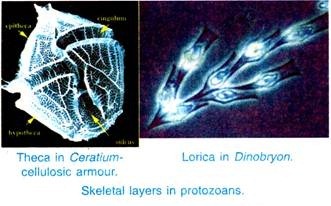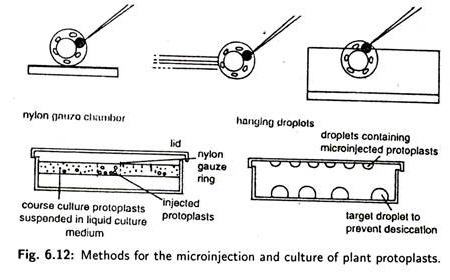ADVERTISEMENTS:
The following points highlight the four structure types of proteins. The types are: 1. Primary Structure 2. Secondary Structure 3. Tertiary Structure 4. Quaternary Structure.
Type # 1. Primary Structure:
Peptide bond is formed by the amino acids linked by carboxyl group of one amino acid with the α-amino group of another amino acid as shown:
H2N-CH2-CO-NH-CH2-COOH
ADVERTISEMENTS:
Glycyl-Glycine
Thus, they form peptide bonds by several amino acids as:
-Ala-Gly-gly-His-leu-
-Ala-Gly-His-Gly-leu-
ADVERTISEMENTS:
The primary structure ultimately becomes as:
Type # 2. Secondary Structure:
Globular proteins indicate a coiled structure in which peptide bonds are folded in a regular manner. The folding’s are the results of linking of the carboxyl and amino groups of the peptide chains by means of hydrogen bonds and disulfide bonds.
Such folding’s are referred to as the secondary structure of the protein. Present evidence suggests that in many proteins, the hydrogen bonding produces a regular coiled arrangement, called α-helix.
α-helix:
a. Pauling and Corey proposed that the polypeptide chain of α-keratin is arranged as an α-helix.
b. In the structure of α-helix it has been found that R groups on the α-carbon atoms exist outward from the centre of the helix.
c. There are 3.6 amino acid residues per turn of the helix.
ADVERTISEMENTS:
d. The distance travelled per turn is 0.54 nm.
e. The spacing per amino acid residue is 0.15 nm.
f. The α-helix is stabilized by hydrogen bonds.
g. Since α-helix is the lowest energy it forms spontaneously.
ADVERTISEMENTS:
h. The right handed helix, when occurs in proteins, is significantly more stable than the left handed helix when the residues are L-amino acids.
i. Certain amino acids like proline tend to disrupt the α-helix.
The β-Pleated sheet:
a. Pauling and Corey also proposed a second ordered structure, the β-pleated sheet β because it was their second structure, the α-helix being the first). In the α-helix the polypeptide chain is condensed, in the β-pleated sheet it is almost fully extended (Fig. 6.5).
ADVERTISEMENTS:
b. In a β-pleated sheet when the adjacent polypeptide chains run in opposite directions (N to C terminus), the structure is termed an antiparallel β-pleated sheet (Fig. 6.5) But when the chains run in the same direction, it is termed parallel.
c. Regions of β-pleated structure are present in many proteins, and both parallel and antiparallel forms occur.
d. The α-helix is stabilized by hydrogen bonding between peptide bonds 4 residues apart in a primary structural sense, stabilization of the β-pleated sheet results from formation of hydrogen bonds between peptides far removed from one another in a primary structural sense.
Type # 3. Tertiary Structure:
The globular protein if completely is composed of a series of single helix, these molecules will have elongated structures with a larger axial ratio (length: breadth). Many proteins are spherical. The special structure in three dimensions is maintained by covalent or other bonds.
Many globular proteins lack in disulphide bonds, yet they are stable in solution. The other bonds like hydrogen bonds, salt bonds and hydrophobic or non-polar bonds are also involved in the stability of the molecule. This has been described as the tertiary structure of protein.
Type # 4. Quaternary Structure:
a. When a protein consists of two or more peptide chains held together by non-covalent interactions or by covalent cross-link, is referred to as quaternary structure.
b. In quaternary structure there are several monomelic units and the primary, secondary, tertiary structures may combine. The polymerization of these monomers or subunits is described as quarternary structure.
c. Glutamic dehydrogenase is tetramer and aldolase molecule is trimer.
Structures of protein related to biological functions of protein:
ADVERTISEMENTS:
i. Enzymes are made up of peptide by peptide linkage (-CONH-) by different amino acid sequences. This follows the primary structure of protein.
ii. Many of the hormones also follow the same method forming peptides which include the primary structure of protein. If any alteration takes place in the proper sequence, there will be the abnormalities in the function.
iii. The globular protein (e.g., many enzymes) have folded, coiled polypeptide chains and axial ratios of less than 10 and generally not greater than 3 to 4. Fibrous proteins have axial ratio greater than 10.
iv. Proteins that bind nucleotides show a nucleotide binding domain of tertiary structure.
v. Most fibrous proteins fulfil structural roles in skin, connective tissue, or fibres such as hair, silk, wool. The typical sequence of amino acid of fibrous protein follow specific secondary tertiary structures.
vi. Silk fibroin contains small quantities of bulky amino acids; these bulky residues interrupt the (3-sheet regions and show the flexibility essential for a successful colour.
ADVERTISEMENTS:
ADVERTISEMENTS:
vii. Tropocollagen, the important unit of collagen, consists of 3 polypeptide chains.
Each polypeptide forms a left handed helix (not an a helix) having 3 residues per turn. 3 left handed helical polypeptide then entwine to form a “right hand” triple or super, helix i.e. stabilized by H bond formed between individual polypeptide chain. Mature collagen fibres show the stable and extended helicle conformation.
Principles of determination of molecular weight of protein:
The proteins have a large molecular weight and they are large macromolecules.
Molecular weight is determined by physical methods such as:
i. Analytic Ultracentrifugation:
It measures the rate at which a protein sediment in a gravitational field. It is an excellent physical technique for the determination of molecular weight.
ii. Sucrose Density Gradient Centrifugation:
It is best applied for globular protein. Protein standards and unknowns are layered on a gradient of buffered 5-20% sucrose. Following overnight centrifugation, the tube contents are removed drop-wise and analysed for protein. Mobility of unknown protein, expressed to standard of known MW, is then computed and MW is calculated.
Gel Filtration:
Columns of sephadex having pores of known size range are calibrated using proteins of known MW. The MW of an unknown protein is then calculated from its elution position relative to these standards.
Polyacrylamide Gel Electrophoresis—Proteins of unknowns and standards are separated by electrophoresis in 5-15% cross-linked acrylamide gels of varying porosity.
In this case, oligomeric proteins are first denatured by boiling them in presence of β- mercaptoethanol and SDS. The denatured proteins are separated on the basis of their size by SDS- PAGE on gels that contain SDS.




